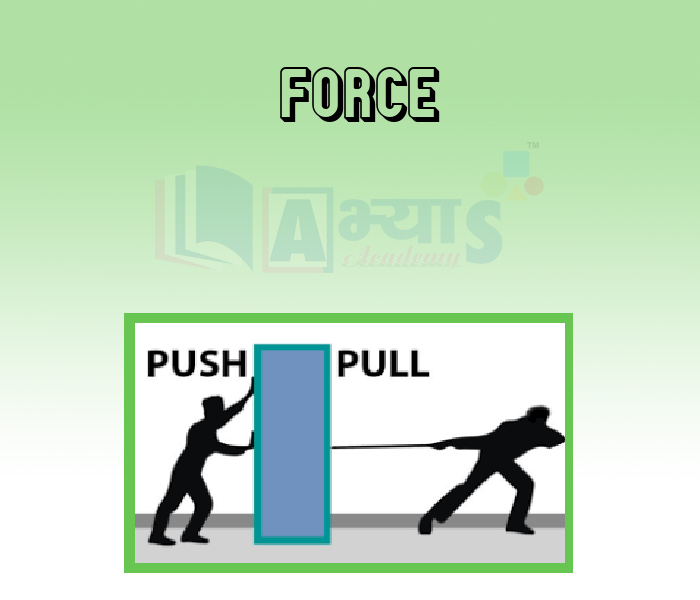Force










Force
In our everyday life, we observe that some efforts are required to put a stationary object into motion or to stop a moving object.
Force:
A pull or push over an object because of its interaction with other object is called force. For example:
1. To open a drawer, one has to pull it; and to close the drawer one has to push it. Thus, in both the conditions a person applies force by pull or push.

2. To kick a ball, one has to push it, i.e. a force is applied.

3. To ride a bicycle one has to push the pedal. In this condition, force is applied while pushing the pedal.

Direction and Magnitude of Force:
While plucking an apple from a tree we pull the apple towards ourselves. Hence we exert FORCE on that object. This also means that force has direction. Also, you push or pull an object gently or hard. This means force has a magnitude. Any action which causes pull, hit or push on a body is called force. Force cannot be seen but it can be judged only by the effects which it produces in various bodies around us.
The SI unit of force is Newton “N”.
Force can produce acceleration in the body on which it acts. When you apply the brakes in your bicycle, you are changing its velocity. Similarly, suppose you press the bulb of a dropper. You are producing a change in the shape of the bulb
State of Rest: An object is called in the state of rest when it is not moving. This means a stationary object is called in the state of rest. For example: a building, an electric pole, a ball kept over the ground and not moving, etc.
State of Motion: A moving object is called in the state of motion. For example – a moving car, a moving ball, etc. A force can speed up a moving object. Force can decrease the speed of a moving object. Force can stop a moving object. Force can change the direction of a moving object. Force can move a stationary object.
An object with mass 2 kg moves with a velocity of 10 m/s .What is the net force on the body? | |||
| Right Option : B | |||
| View Explanation | |||
Force is defined as ______________ | |||
| Right Option : C | |||
| View Explanation | |||
In which of the following cases the net force is zero ? a) A car drives around a circular race track at a constant speed b) A person holds the door to enter the room c) A ball, rolling across a grassy field, slowly comes to a stop | |||
| Right Option : B | |||
| View Explanation | |||
Students / Parents Reviews [10]
One of the best institutes to develope a child interest in studies.Provides SST and English knowledge also unlike other institutes. Teachers are co operative and friendly online tests andPPT develope practical knowledge also.

Aman Kumar Shrivastava
10thI have spent a wonderful time in Abhyas academy. It has made my reasoning more apt, English more stronger and Maths an interesting subject for me. It has given me a habbit of self studying

Yatharthi Sharma
10thMy experience with Abhyas is very good. I have learnt many things here like vedic maths and reasoning also. Teachers here first take our doubts and then there are assignments to verify our weak points.

Shivam Rana
7thIt was good as the experience because as we had come here we had been improved in a such envirnment created here.Extra is taught which is beneficial for future.

Eshan Arora
8thAbout Abhyas metholodology the teachers are very nice and hardworking toward students.The Centre Head Mrs Anu Sethi is also a brilliant teacher.Abhyas has taught me how to overcome problems and has always taken my doubts and suppoeted me.

Shreya Shrivastava
8thAbhyas is a complete education Institute. Here extreme care is taken by teacher with the help of regular exam. Extra classes also conducted by the institute, if the student is weak.

Om Umang
10thAbhyas Methodology is very good. It is based on according to student and each child manages accordingly to its properly. Methodology has improved the abilities of students to shine them in future.

Manish Kumar
10thIt was a good experience with Abhyas Academy. I even faced problems in starting but slowly and steadily overcomed. Especially reasoning classes helped me a lot.

Cheshta
10thMy experience was very good with Abhyas academy. I am studying here from 6th class and I am satisfied by its results in my life. I improved a lot here ahead of school syllabus.

Ayan Ghosh
8thMy experience with Abhyas academy is very good. I did not think that my every subject coming here will be so strong. The main thing is that the online tests had made me learn here more things.
